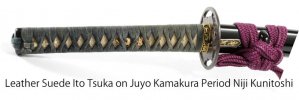- Joined
- Oct 9, 2011
- Messages
- 758
Is there a term for having a thin or thick tsuka? I have looked through various forums and websites and can't seem to find anything specific to the thickness of the tsuka.
I am 6' 2" and have fairly large hands and most tsuka cramp the area between my thumb and index finger in just a few minutes of practice. I have found that some of the cheaper katana like the Raptor line that Bugei and Hanwei put out was perfect for my hands. Those are wrapped in suede, which I don't believe was traditional. The Hanwei Tori Elite is also one that fits my hands perfectly, but again, they are wrapped in leather instead of silk.
I know I could always wear gloves, but I don't want to be "that guy". I will hopefully be returning to Japan next year and may get a custom iaito from Nosyudo and I know they measure your hands during the design process. I will most likely have my answer at the point, but I was wondering if anyone here had any additional info.
I am 6' 2" and have fairly large hands and most tsuka cramp the area between my thumb and index finger in just a few minutes of practice. I have found that some of the cheaper katana like the Raptor line that Bugei and Hanwei put out was perfect for my hands. Those are wrapped in suede, which I don't believe was traditional. The Hanwei Tori Elite is also one that fits my hands perfectly, but again, they are wrapped in leather instead of silk.
I know I could always wear gloves, but I don't want to be "that guy". I will hopefully be returning to Japan next year and may get a custom iaito from Nosyudo and I know they measure your hands during the design process. I will most likely have my answer at the point, but I was wondering if anyone here had any additional info.

